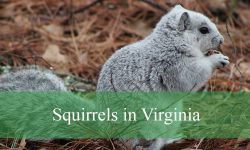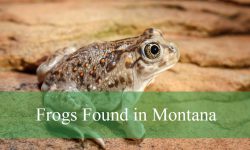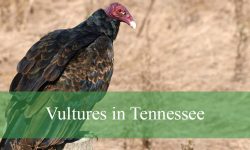If you enjoy birdwatching, Connecticut offers an excellent chance to see a variety of woodpeckers throughout the year. From the tiny Downy Woodpecker to the impressive Pileated Woodpecker, these birds bring life and sound to forests, parks, and even backyards.
Each species has unique traits that make them fascinating to observe. Some are year-round residents that thrive in suburban yards, while others are migratory visitors that stop by during spring and fall. Even rare species occasionally appear, making birding in Connecticut especially exciting.
In this guide, we’ll explore 8 types of woodpeckers in Connecticut, complete with their identifying features, habitats, and behaviors.
Different Types of Woodpeckers Found in Connecticut
Downy Woodpecker (Dryobates pubescens)
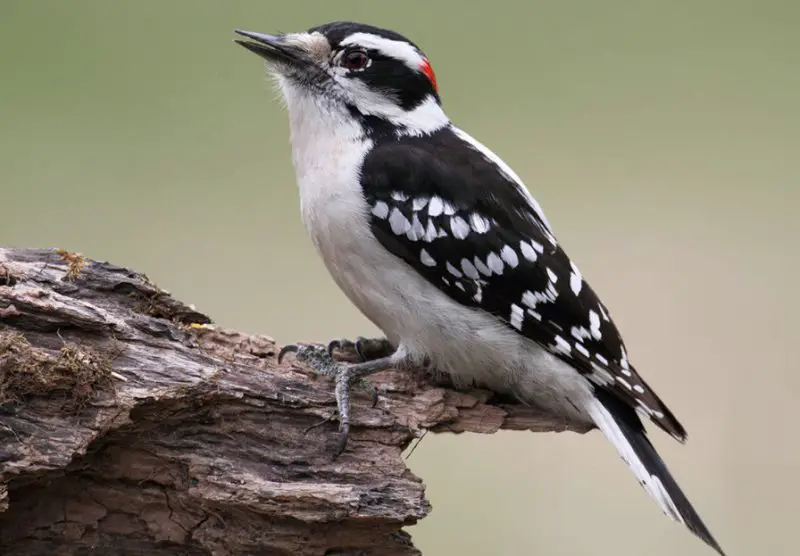
The Downy Woodpecker is the smallest of all woodpeckers found in Connecticut, measuring only about 6–7 inches in length with a wingspan of 10–12 inches. It has a compact body with a short, stubby bill that looks smaller than expected for a woodpecker. Its plumage is marked with crisp black-and-white patterns, and males have a small red patch on the back of the head. This tiny bird is often confused with the Hairy Woodpecker, but its smaller size and shorter bill are reliable features for identification.
This species is a year-round resident in Connecticut, thriving in both rural woodlands and suburban areas. They are one of the most frequent visitors to backyard bird feeders, especially when suet is provided. Their adaptability to a wide range of habitats makes them one of the most familiar woodpeckers to local birdwatchers.
Behaviorally, Downy Woodpeckers forage actively along tree trunks and thin branches, often hanging upside down to reach insects hidden beneath the bark. Their diet includes beetles, ants, caterpillars, as well as seeds and berries when insects are less available. Their drumming is fast and light, often used to establish territory and attract mates.
Downy Woodpeckers are beneficial to forest health, helping control insect populations. Their small size allows them to exploit feeding niches on twigs and stems where larger woodpeckers cannot. Despite their tiny stature, they are hardy birds, enduring Connecticut’s cold winters with surprising resilience.
Hairy Woodpecker (Dryobates villosus)
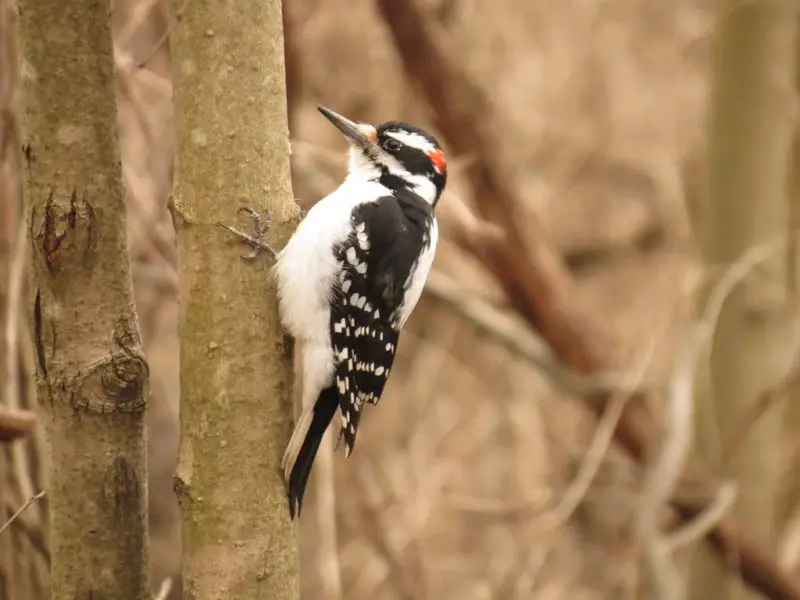
The Hairy Woodpecker is noticeably larger than the Downy, reaching 9–11 inches in length with a wingspan of 13–16 inches. It has almost identical black-and-white plumage but sports a much longer, chisel-like bill nearly equal to the length of its head. This strong bill is adapted for drilling deeper into bark compared to the smaller Downy. Males can be recognized by a red patch at the back of the head.
In Connecticut, the Hairy Woodpecker is also a year-round resident, favoring mature forests, wooded parks, and suburban neighborhoods with large trees. While they sometimes visit suet feeders, they are less common around homes than the Downy. Their larger size and stronger excavating ability make them more suited to old-growth forests and areas with abundant deadwood.
They are powerful foragers, often leaving behind deep rectangular holes in search of beetle larvae and wood-boring insects. Their diet consists primarily of insects, though they will also eat seeds, nuts, and fruit when available. Their loud, sharp “peek” call is one of the easiest ways to locate them in Connecticut’s forests.
Hairy Woodpeckers are important indicators of healthy woodlands, since their presence often reflects a rich insect population and suitable nesting habitat. Their energetic drumming can echo far through the woods, signaling both their territory and courtship activity during the breeding season.
Northern Flicker (Colaptes auratus)
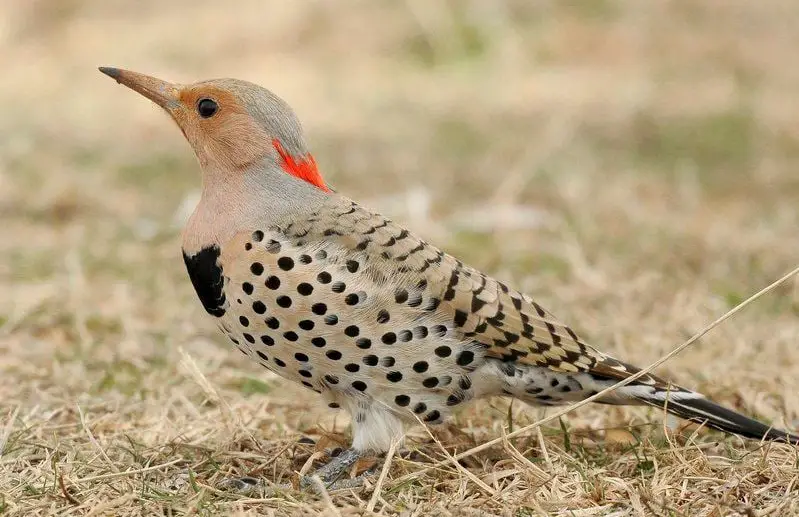
The Northern Flicker is one of the largest woodpeckers in Connecticut, growing to 11–14 inches in length with a wingspan of 16–20 inches. Unlike most woodpeckers, Flickers have a more brownish appearance with black spots on the belly, a black crescent on the chest, and a striking white rump visible in flight. In Connecticut, the Yellow-shafted Flicker variety is common, with yellow underwings and tail feathers. Males also have a black mustache-like stripe on the face.
Unlike other woodpeckers that forage primarily on trees, Northern Flickers spend much of their time on the ground. They probe the soil with their long, sticky tongues to feed on ants and beetles, which make up a significant portion of their diet. This ground-foraging behavior makes them easy to spot in open fields, lawns, and forest edges.
The Northern Flicker is a year-round resident in Connecticut, though some individuals migrate further south during harsh winters. They prefer habitats that combine open spaces with scattered trees, such as meadows, suburban areas, and woodland edges. Their loud “wick-a-wick-a-wick” calls are distinctive and often heard before the bird is seen.
Because of their striking plumage, unique feeding habits, and flashy wing and tail colors in flight, Northern Flickers are among the most recognizable and charismatic woodpeckers in Connecticut. They play an important role in ecosystems by controlling insect populations and occasionally using old nest cavities of other birds.
Pileated Woodpecker (Dryocopus pileatus)
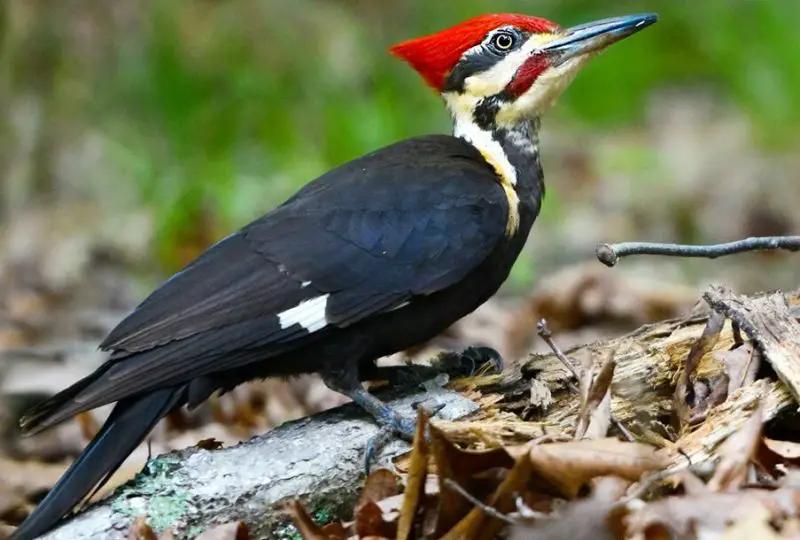
The Pileated Woodpecker is the largest woodpecker in Connecticut, reaching an impressive 16–19 inches in length with a wingspan of 26–30 inches. Its striking black plumage is accented by bold white stripes running down the neck and a spectacular red crest atop its head. Males have an extra red streak on their cheeks, while females lack this feature. Their size and loud calls make them one of the most dramatic forest birds to encounter.
This species favors large tracts of mature forest, though it can adapt to suburban wooded areas with sufficient tree cover. They are year-round residents in Connecticut, often requiring old trees and snags for both nesting and foraging. Their presence is often revealed by large rectangular holes carved into dead or decaying trees, where they dig for carpenter ants and beetle larvae.
Pileated Woodpeckers feed primarily on ants, insects, and wood-boring beetles, but they also eat fruits and nuts, especially in the fall and winter. Their long, barbed tongues can extend far into crevices, making them efficient at extracting insects deep within wood. Their foraging activity creates cavities that are later used by owls, ducks, and other cavity-nesting species.
Their calls are loud, echoing “cuk-cuk-cuk” sounds that can be heard across long distances, and their drumming is powerful enough to resonate throughout the forest. The Pileated Woodpecker is often seen flying with deep, crow-like wingbeats, and its size alone makes it an unforgettable sight for Connecticut birdwatchers.
Red-bellied Woodpecker (Melanerpes carolinus)
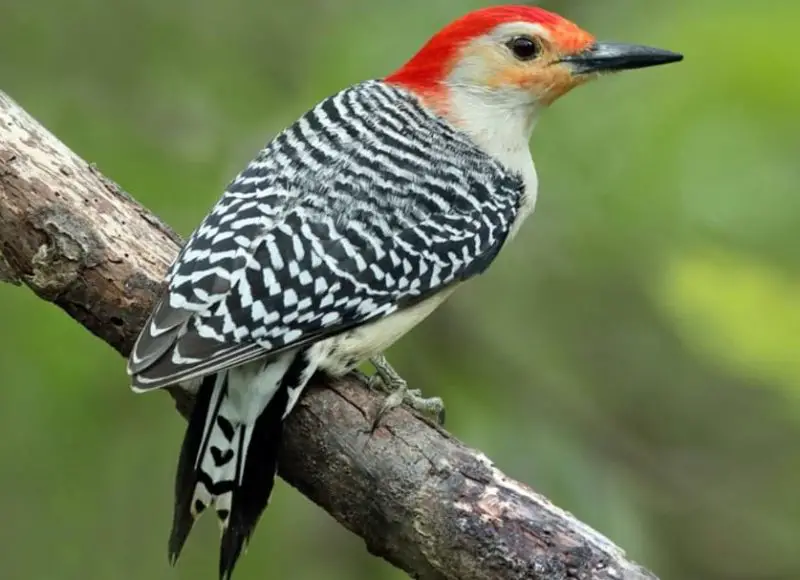
The Red-bellied Woodpecker is a medium-sized species, measuring 9–10.5 inches in length with a wingspan of 15–18 inches. Despite its name, the reddish tinge on its belly is often faint and hard to notice. Its most striking features are the black-and-white barred back and the vivid red coloration on the head, which extends from the bill to the neck in males and only on the nape in females.
This species has been expanding its range northward over the past century and is now a common year-round resident in Connecticut. It thrives in mixed forests, suburban areas, and wooded parks, frequently visiting backyard feeders. Suet, peanuts, and sunflower seeds are some of its favorite food items when provided by people.
Red-bellied Woodpeckers are versatile foragers, feeding on insects, nuts, seeds, and fruits. They are also known for caching food in bark crevices to retrieve later. Their loud, rolling “churr” calls are commonly heard throughout Connecticut, making them easier to detect than to see.
These woodpeckers play an important ecological role, both as insect controllers and as secondary cavity providers, since other species often use their old nesting holes. Their adaptability to human-altered environments has allowed them to flourish across the state.
Yellow-bellied Sapsucker (Sphyrapicus varius)
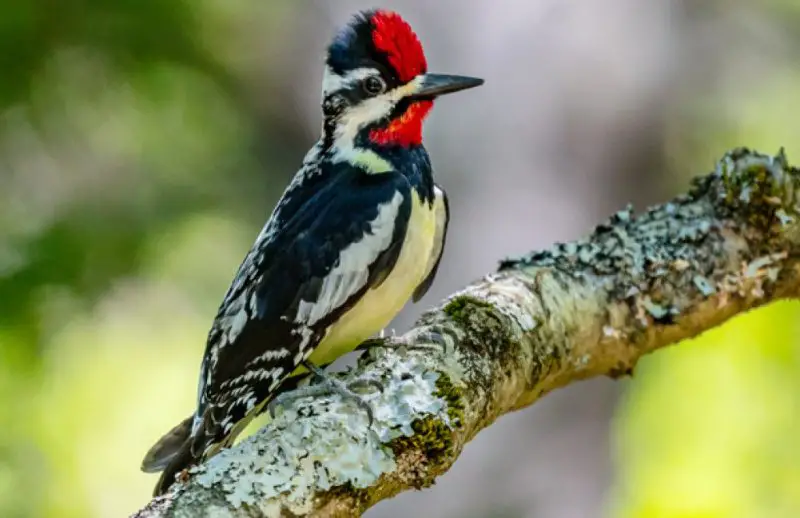
The Yellow-bellied Sapsucker is a medium-sized migratory woodpecker, about 7–8.5 inches long with a wingspan of 13–16 inches. It has a patterned black-and-white back, a pale belly washed with yellow, and a bold white wing stripe. Males show both a red crown and red throat, while females have only the crown.
This is the only truly migratory woodpecker in Connecticut, most often seen during spring and fall migrations. Some individuals stay in the state during winter, but sightings are less common compared to the breeding range farther north. They are best identified by the neat rows of small holes they drill into trees.
Sapsuckers feed primarily on tree sap, which they access by drilling their signature sap wells. They also consume insects drawn to the sap, as well as some fruits. Preferred trees include birches, maples, and fruit trees, which show the telltale rows of sap holes.
Although not as common as other Connecticut woodpeckers, their irregular drumming—consisting of uneven, stuttering beats—and distinctive mewing call make them recognizable when present. Their unique feeding behavior has a ripple effect, benefiting hummingbirds and other species that also sip from sap wells.
Red-headed Woodpecker (Melanerpes erythrocephalus)
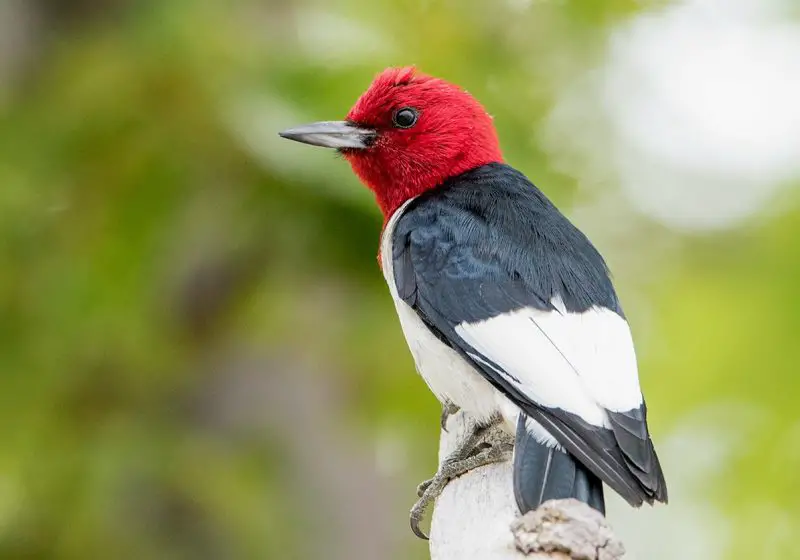
The Red-headed Woodpecker is one of the most visually striking woodpeckers in North America, measuring 7.5–9.5 inches in length with a wingspan of 16–17 inches. It has a completely crimson head, contrasting sharply with its snow-white belly and black-and-white wings. This bold coloration makes it unmistakable in the field.
In Connecticut, this species is considered an uncommon and irregular visitor, more often seen in open woodlands, orchards, or along forest edges. Habitat loss and population declines across its range have made it less frequent in the Northeast, making any sighting noteworthy for birders.
Red-headed Woodpeckers are excellent aerial hunters, often catching insects mid-flight in addition to foraging for nuts, seeds, and fruits. They are also known for their food-storing behavior, sometimes wedging acorns and insects tightly into tree bark.
Their loud, shrill calls carry over long distances, helping observers locate them even when they are high in the canopy. Despite their rarity in Connecticut, they remain a highly desired species for birdwatchers due to their brilliant coloration and lively behavior.
Black-backed Woodpecker (Picoides arcticus)
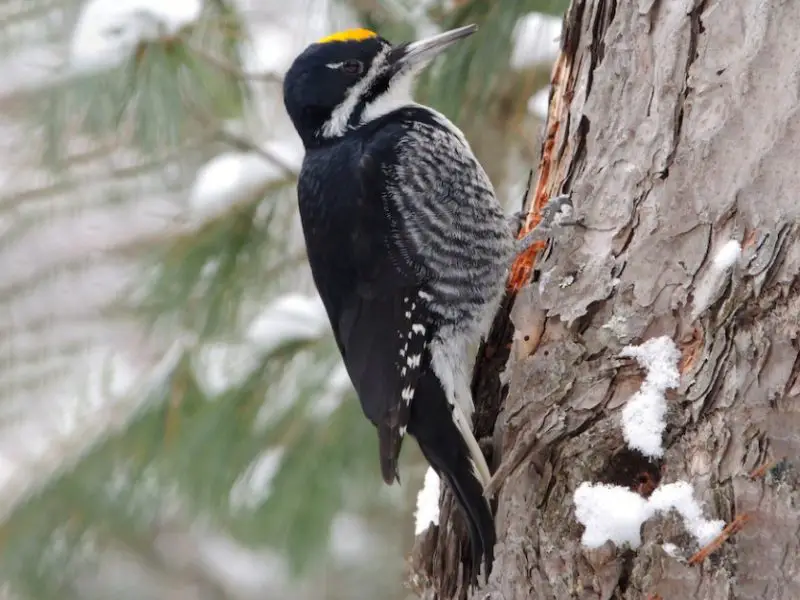
The Black-backed Woodpecker is a northern species rarely seen in Connecticut, measuring 9–10 inches long with a wingspan of 15–16 inches. Its plumage is almost entirely black on the back, wings, and head, with a contrasting white belly and a single white stripe along the back. Males are distinguished by a small yellow crown patch.
This bird is strongly associated with recently burned coniferous forests and old spruce or pine stands. It is considered a very rare visitor in Connecticut, usually appearing only in winters when food shortages push individuals farther south than normal. Most Connecticut sightings are considered special events among local birding communities.
Black-backed Woodpeckers specialize in feeding on wood-boring beetle larvae, which thrive in fire-killed trees. Their strong bills allow them to strip bark from trunks in search of hidden prey, leaving behind noticeable bark scaling as a sign of their presence.
Because of their rarity, observing a Black-backed Woodpecker in Connecticut is a remarkable experience. Their slow, steady drumming and deliberate foraging style set them apart from more common local species. For dedicated birdwatchers, this woodpecker represents one of the most exciting possible finds in the state.
Best Time and Places to See Woodpeckers in Connecticut
Woodpeckers can be observed in Connecticut throughout the year, with the best viewing opportunities depending on the species. Resident species such as the Downy, Hairy, Red-bellied, Pileated, and Northern Flicker can be seen in every season. Winter is often a great time to watch them, since leafless trees make spotting easier and many birds visit backyard feeders for suet and seeds.
During spring and summer, woodpeckers are more vocal and active as they establish territories, drum on trees, and feed their young. This is the best time to hear their distinctive calls and drumming patterns. Migratory species like the Yellow-bellied Sapsucker are easiest to find during spring and fall migration, when they pass through the state.
For the best locations, visit large tracts of forest, state parks, and wildlife preserves. Pileated Woodpeckers are most often found in mature forests such as those in Litchfield County, while Downy and Hairy Woodpeckers are widespread even in suburban backyards. Northern Flickers can often be spotted in open meadows, fields, and forest edges, while Red-headed and Black-backed Woodpeckers are rare but may be seen in specific habitats such as orchards or coniferous stands.
FAQs About Woodpeckers in Connecticut
What woodpeckers stay year-round in Connecticut?
Five species live in Connecticut year-round: the Downy Woodpecker, Hairy Woodpecker, Northern Flicker, Pileated Woodpecker, and Red-bellied Woodpecker. These can be found in both forests and suburban areas.
Are there any migratory woodpeckers in Connecticut?
Yes, the Yellow-bellied Sapsucker is the only truly migratory woodpecker in the state. It is most often seen during spring and fall migration, although some may overwinter in mild years.
Which woodpecker is the largest in Connecticut?
The Pileated Woodpecker is the largest species in the state, reaching up to 19 inches in length with a wingspan close to 30 inches. Its loud calls and striking red crest make it easy to recognize.
Can I attract woodpeckers to my backyard?
Yes. Suet feeders, peanut feeders, and black oil sunflower seeds are excellent ways to attract woodpeckers. Leaving dead trees or snags in your yard, if safe, also provides natural foraging and nesting opportunities.
What is the rarest woodpecker in Connecticut?
The Black-backed Woodpecker is considered the rarest, appearing only as a winter visitor in exceptional years. The Red-headed Woodpecker is also rare and irregular but still spotted occasionally in orchards or open woodlands.

